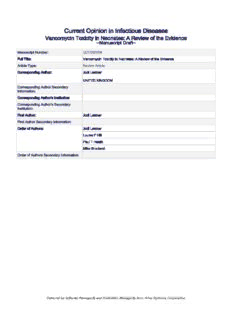Table Of ContentPoweredbyEditorialManager®andProduXionManager®fromAriesSystemsCorporation
Vancomycin Toxicityin Neonates:A Review of the Evidence
LestnerJM1,Hill LF2,HeathPT2,SharlandM2
Universityof Liverpool, UK
St George's, Universityof London, UK
CorrespondingAuthor
DrJodi Lestner
Antimicrobial Pharmacodynamics &Therapeutics (APT)Group
Universityof Liverpool
1.12Sherrington Buildings
AshtonStreet
Liverpool
L693GE
Tel: +44(0)1517945466
Email: [email protected]
ABSTRACT
Purposeof review:
Vancomycinis afirst-lineagentinthe treatment ofserious Gram-positiveinfections
intheneonatal population. The publishedevidenceonvancomycintoxicityin
neonates is limited. This reviewsummarises pre-clinical studies andclinical trials
describingvancomycintoxicity.Wediscuss proposedpathophysiologyand
summariseevidencesupportingdose-response relationships, genetic and
environmental determinants, andconsider futureresearchrequiredtofurtherdefine
vancomycintoxicity.
Recentfindings:
Current dosing regimens forvancomycin result insub-therapeuticlevels in alarge
proportionofpatients. Higher dailydoses havebeenproposed,whichhave ledto
concerns regardingincreasedtoxicity.Nephrotoxicityoccurs in1-9%ofneonates
receivingcurrentlyrecommendeddoses. Theincidenceis highest inthose receiving
concomitant nephrotoxic drugs. Vancomycin-associatedototoxicityis rareinpatients
ofall ages. Exposure-toxicityrelationships inrelationtonephro-andototoxicityhave
not beenclearlydefinedinneonates receivingvancomycin.
Summary:
Current evidencesupports thefavourablesafetyprofile ofvancomycininneonates.
Furtherstudies that address safetyconcerns relatingtohigh-doseintermittentdosing
regimens areneeded.Suchstudies must includerobust andstandardiseddefinitions of
renal andhearingimpairment,andincludefollow-upofsufficient lengthto establish
thelong-term implications of experimental findings.
KEYWORDS
Vancomycin,toxicity, neonates, renalimpairment,hearingloss
INTRODUCTION
Vancomycinis a glycopeptide bactericidalantibioticthatdisrupts cell wall synthesis
inGram-positivebacteria. (1) Impurities from earlyfermentationprocesses were
associatedwithsignificant toxicitywhenthedrugwasfirst introducedintheearly
thedisparaging
thesafetyprofileofvancomycin,and Foodand DrugAdministrationapproval was
grantedin1958. Despitethis,
use. Inrecentdecades clinical usehas increased,however,owingtothe rising
incidenceofinfectionscausedbymethicillin-resistantStaphylococcus aureus and
otherresistant Gram-positivepathogens that aresusceptibletovancomycin. (2)
Vancomycindosingstrategies varygreatlyandaregenerallybasedonacombination
ofpost-menstrual age (PMA),post-natal age(PNA),weight and/or renal function(see
table1). Therapeuticdrugmonitoring(TDM)is widelyadvocated.Currentlyclinical
guidelines recommendtarget troughconcentrations of 10-15 (3,4) However,
recent studies suggest the needfortarget troughlevels >15 ,basedonthe
concernthat lowertroughconcentrations maybe selectiveforhetero-resistance.(5-7)
In adults, higher dailydoses ofvancomycin (15mg/kg6hourly) have yet toreceive
regulatoryapproval but havebeenproposedinrecentconsensus documents published
bythe Infectious Diseases SocietyofAmerica, AmericanSocietyof Health-System
Pharmacists, andtheSocietyof Infectious Diseases Pharmacists. (8-10) Theuseof
highervancomycindoses has raisedconcerns regardingthe potentiallyincreasedrisk
oftoxicity.Thesignificanceoftheseconcerns in paediatric populations is unclear.
Here wesummarisethe current evidencerelatingtovancomycintoxicityincluding
proposedpathophysiology, dose-toxicityrelationships, geneticandenvironmental
factors and future researchneeds. Studies pertainingtovancomycin-inducedtoxicity
betweenMarch1950 and March2015wereidentifiedfrom PubMed,Embase,
CochraneControlledTrial Registry,andMedlinedatabases. Thefollowingsearch
NEPHROTOXICITY
Quantification of Nephrotoxicity
Kidneyfunctionis difficult todefineinthefirst monthof lifewhenrenal physiology
andfluidbalanceevolve rapidly.Serum creatinine (SCr)concentrations reflect
maternal renal functioninthe first 48hours after birth.(11,12) Inaddition,preterm
infants experience ariseinSCrduetotubularreabsorption,makingthis animprecise
proxyfor glomerular filtration. (13)Clinical reports alsooftenomit details of the
laboratorymethods used toquantifySCr(Jaffé colorimetry, enzymaticquantification,
orisotopedilutionmass spectroscopy),whichcan haveaninter-test variabilityofup
to25%inneonates. (14, 15)Despitetheselimitationsmost studies definerenal
impairment as anincreaseinSCr. (16-19)Definitions forchildren andneonates have
beenreportedbasedonseveral classifications systems, all ofwhichwereoriginally
developedandvalidatedinadults. (20,21)Modifiedneonatal criteriaexcludeurine
output oruseahighercut-off(<1.0mL/kg/h) inorder toaccount forthenon-oliguric
renal dysfunctionthat occurs inneonates duetofluidredistributionandimpaired
absorptionintheimmaturerenal tubule.(22,23)
Pre-Clinical Studies
Murinemodels havedemonstratedthatvancomycinhas anaffinityforbiological
membranes and accumulatesinrenal tissue.(24,25)Theenergy-dependent transport
mechanisms withinthe tubularepithelium render thekidneyhighlysusceptibleto
toxin-induced cellularinjury. Vancomycin enhances cellularATP concentrations and
stimulateoxygenconsumption,resultinginoxidativephosphorylation. (26-31)
However,oxidative stress of sufficientmagnitude tocauseclinicallydetectablerenal
impairment has not been demonstratedinanimals, evenatsupra-therapeuticdoses.
(32)Histopathologicalchanges andbiochemical evidenceofnephrotoxicityhavebeen
observedinanuninfectedmurinemodelinwhichhigh-dosevancomycin was co-
administeredwithtobramycin. (25)
Clinical Studies
ThelinearrelationshipbetweenSCrandvancomycin exposurereflects thedrugs
primaryrouteof eliminationthroughrenal excretion.As aresult,adecreaseinrenal
functionfrom anycause will increaseserum vancomycinconcentrations, a fact that
confounds theestablishment ofexposure-toxicityrelationships. (33)Manystudies
that describevancomycin-associatednephrotoxicityareconductedinpatients
otherwiseat risk of renal impairment,suchas thoserequiringintensive care and
frequentlyincludethose receivingother potentiallynephrotoxic drugs (e.g. NSAIDs,
diuretics andaminoglycosideantibiotics).However,irrespectiveof thedifficultyin
definingcausal relationships, acutekidneyinjuryfromanycauseis associatedwitha
significantlyincreasedrisk of mortality,hospital lengthofstay,andcost,evenafter
adjustment forage,gender,chronickidneydisease,andco-morbidities atadmission.
(34)
Adult Studies
Nephrotoxicityinpatients receivingvancomycin hasbeenmoresystematically
reportedinadults thanin neonates and children.Thereportedincidenceof
nephrotoxicityinadults receivingvancomycinis10-15%.(35) Inarecent meta-
analysis, vanHal,et al.reviewedfifteenstudies inwhichvancomycinwas
administeredvia intermittent infusiontoadults >18 years ofage.Randomisedtrials
andobservationalstudies in whichdataonrenal functionandtroughvancomycin
concentrations wereavailablewereincluded.The analysis foundtrough
nephrotoxicity(OR,2.67; 95%CI,1.95-3.65),and also suggestedanincremental
increaseinnephrotoxicityrisk withvancomycinadministration beyondsevendays.
(36)Themajorityof reportedcases wereselfresolving,withprolongedimpairment
requiringshort-term dialysis occuringin3%ofcases. Similarly, aretrospectivecohort
studyof246adultsreceivingintermittent-dosingofvancomycinfordurations of>48
hours foundtoxicitytobecorrelatedwithexposure(basedondose).Patients
comparedwiththosereceiving<4 gdaily(34.6% vs.10.9%; p=0.001).(18)
Concomitant aminoglycosideusehas consistentlybeenshowntoincreasetherisk of
nephrotoxicityinadults receivingvancomycin. In2007,Fowler, et al reporteda
seminal open-label randomisedtrial of daptomycinversus either anti-staphylococcal
penicillinorvancomycin plus low-dosegentamicinin236patientswith S.aureus
bacteremia.Thehighest proportionofrenal impairment occurredinpatients receiving
vancomycinplusgentamicin(20.4%),althoughthis was not significantlyhigherthan
withpenicillinplus gentamicin(18.6%).
Furthermore,thestudyfoundthatthehighest incidenceof renalimpairmentin
patients receivingvancomycinoccurredlaterintreatment,peakingat 14-28days. (37)
Paediatric &Neonatal Studies
Vancomycinadministration withintermittentdosingandin accordancewith
publishedguidancehasbeenshowntoresult insub-therapeutictroughconcentrations
inuptohalfoftreatedneonates. (4)Furthermore, antimicrobial point prevalence
surveys that describeprescribingpractices havedemonstratedthat significant
variationinprescribingof vancomycininneonates exists inclinical practice,witha
largeproportionofneonates receivingdailydoses ofvancomycinthat are
significantlybelow eventhe most conservativecurrent recommendations. (38)Table
2outlines theclinicalstudiesthat havereportednephrotoxicityassociatedwith
vancomycinuse inneonatesandinfants. Themajorityofstudies identified are
heterogeneous observational oropportunisticpharmacokinetic studies basedon
routineTDM andareinsufficientlypoweredtodetect toxicity.
As withadults, casesof renal impairment aremorefrequentlyreportedinneonates
andchildrenreceivingconcomitant nephrotoxic drugs. (19,35)Eight often studies
describingconcomitant nephrotoxicdrugs alongsidevancomycintherapy
demonstratedevidenceof renal impairment,whichwas mildandtransient inall
reported cases (seetable 2). Otherreports havenot foundvancomycinto bean
independent predictorof nephrotoxicity.Constance,et al,forexample,foundno
significant differenceintheproportionofneonates developingnephrotoxicityinthose
receivingvancomycinplus gentamicin (12/533,2.2%)versus those receiving
gentamicinalone(7/533, 1.3%). Logistic regressiondemonstratedthatwhilepositive
bloodculture,lowbirthweight,patentductus arteriosus,concomitant non-steroidal
anti-inflammatorydrug(NSAID)use, andillness severitywereall independent risk
factors fornephrotoxicity,vancomycininconjunction withgentamicinwas not.(23)
Six studiesreport rates ofnephrotoxicityinneonatesreceivingvancomycin alone.A
transient riseinSCr,microproteinuria,and elevatedNAGwere reportedinonlythree,
twoandonepatient, respectively(seetable2).(51,54,59-61)
Exposure-toxicityrelationships havenot beenclearlydefinedfor vancomycinin
neonates. Two case reports havedescribedclinical outcomes infourneonates
receivingaccidental overdoses ofupto10-foldthemaximumrecommendeddose.
(51,59)All fourpatients developedtransient renal impairment,thoughall hadnormal
renal functionat6months. It is noteworthythat thesecases all involvedsingleor
briefexposures that weremanagedwithimmediatevancomycinwithdrawal,andso
thesefindings donot address thepotential risk of cumulativeexposure.
Anumberofrecentstudieshavedescribedthe administrationofvancomycinvia
continuous infusioninneonates. Continuous infusionhas thetheoreticaladvantage of
maintainingconstantplasma concentrations, meaningthat overall drugexposurecan
beincreasedwithout ariseinpeakconcentrations. Studiesinvestigatingcontinuous
vancomycininfusionsinneonateshave,todate,been basedonstudies defined
toxicitydifferentlyandinvolvedsmall patient cohorts that receivedvaried dosing
regimens. Aloadingdose of 7-15mg/kgwas givenin threestudies. Collectively,the
results ofthesestudiessuggest that continuous infusion mayresult inahigher
proportionofpatientsachievingtarget concentrations between15-
Reportedrates ofnephrotoxicitydonot differsignificantlyfrom thoseinpatients
receivingintermittent dosing,andthereis currentlyno evidencetosuggest theuseof
aloadingdoseincreases therisk ofnephrotoxicity. (3,45,47,60) Continuous
infusions may,however,beimpractical intheneonatalpopulationwherevenous
access iflimited,andmayleadtoperiods without effectiveantibioticcover ifaccess
is lost.Therehave, as yet,beennosystematicstudiescomparingthesafetyand
efficacyof continuous infusionwithhigh-doseintermittentregimens that specifically
OTOTOXICITY
Quantification ofOtotoxicityin Neonates
Theassessment ofhearingininfants is challenging. Behaviouraltests (e.g. visual
reinforcement audiometry) arethe goldstandard, butcannot be performed reliablyin
childrenbelow~8months. (67)Themethods currentlyemployedtoquantifyauditory
functioninneonates are otoacoustic emissions (OAE)andauditorybrainstem
responses (ABR).Serial diagnosticOAEandABR testinghas beenusedtomonitor
ototoxicityin childrenreceivingaminoglycosides. (68-71)Thereareno equivalent
reports describingserial OAEorABR followingvancomycinuse.DiagnosticOAEor
ABR is labour-intensive anddifficulttointerpret inprematureinfants(PMA<34
weeks)dueto immaturityof the cochleaand centralauditorypathways (72-78).
Universal newbornhearingscreening(UNHS)uses acombinationofautomatedOAE
andABR,andis designedtoidentifyseverepermanent hearingimpairmentinterm
neonates. Standardised UNHS programmes arenowbeingimplementedintheUSA
Description:Powered by Editorial Manager® and ProduXion Manager® from Aries . Constance, et al, for example, found no .. renal failure 2nd to a .. Acta paediatrica Japonica; Overseas edition 38:619-621. 62. Wold JS, Turnipseed SA.

